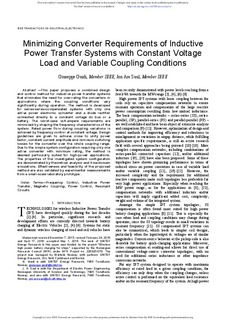| dc.contributor.author | Guidi, Giuseppe | |
| dc.contributor.author | Suul, Jon Are Wold | |
| dc.date.accessioned | 2017-01-18T15:01:32Z | |
| dc.date.available | 2017-01-18T15:01:32Z | |
| dc.date.created | 2016-12-08T15:29:40Z | |
| dc.date.issued | 2016 | |
| dc.identifier.citation | IEEE transactions on industrial electronics. 2016, 63 (11), 6835-6844. | nb_NO |
| dc.identifier.issn | 0278-0046 | |
| dc.identifier.uri | http://hdl.handle.net/11250/2427723 | |
| dc.description.abstract | This paper proposes a combined design and control method for inductive power transfer systems that eliminates the need for overrating the converters in applications where the coupling conditions vary significantly during operation. The method is developed for series–series compensated systems with only one active power electronic converter and a diode rectifier connected directly to a constant voltage dc bus or a battery. The worst-case voltampere requirements are minimized by shaping the frequency characteristics of the system. Rated power flow during coupling variations is achieved by frequency control at constant voltage. Design guidelines are given to achieve close to unity power factor, constant current amplitude, and minimum switching losses for the converter over the whole coupling range. Due to the simple system configuration requiring only one active converter with minimum rating, the method is deemed particularly suited for highpower applications. The properties of the investigated system configuration are demonstrated by theoretical analysis and time-domain simulations. Effectiveness and feasibility of the proposed method are also validated by experimental measurements from a small-scale laboratory prototype. | nb_NO |
| dc.language.iso | eng | nb_NO |
| dc.title | Minimizing Converter Requirements of Inductive Power Transfer Systems With Constant Voltage Load and Variable Coupling Conditions | nb_NO |
| dc.type | Journal article | nb_NO |
| dc.type | Peer reviewed | nb_NO |
| dc.rights.holder | IEEE | nb_NO |
| dc.source.pagenumber | 6835-6844 | nb_NO |
| dc.source.volume | 63 | nb_NO |
| dc.source.journal | IEEE transactions on industrial electronics | nb_NO |
| dc.source.issue | 11 | nb_NO |
| dc.identifier.doi | 10.1109/TIE.2016.2582459 | |
| dc.identifier.cristin | 1410344 | |
| dc.relation.project | Norges forskningsråd: 226325 | nb_NO |
| cristin.unitcode | 7548,50,0,0 | |
| cristin.unitname | Energisystemer | |
| cristin.ispublished | true | |
| cristin.fulltext | postprint | |
| cristin.qualitycode | 2 | |
